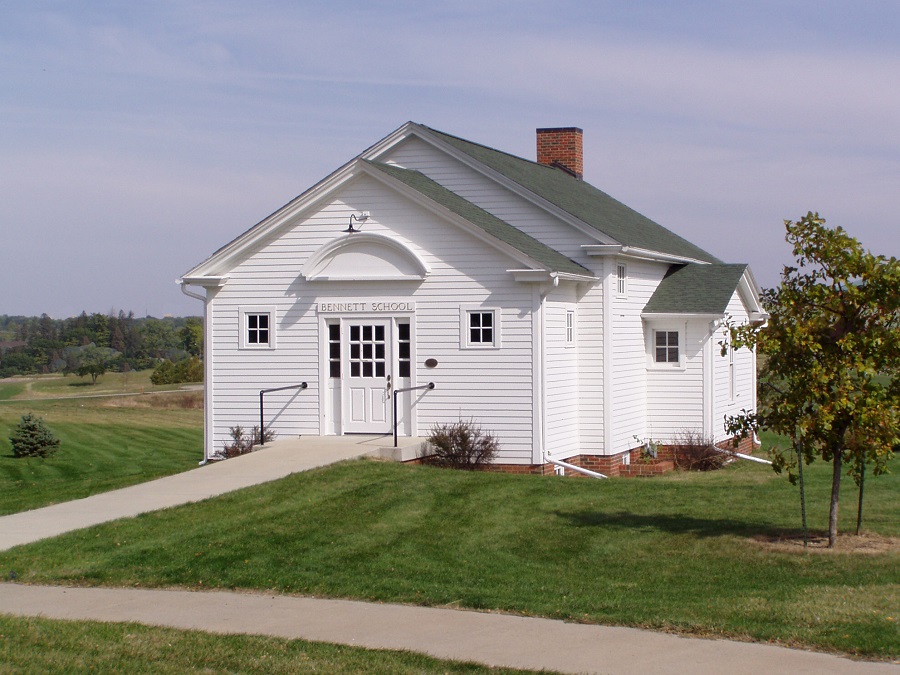Jordan House
 James C. Jordan, a cattle farmer from Virginia and one of Iowa’s most influential early settlers built the Jordan House. When Jordan settled the area, he chose a beautiful location with ancient oak, walnut and hickory trees on land gently sloping to the Raccoon River. Jordan’s first shelter was a lean-to tent, which was replaced in 1848 with a log cabin. In 1850 he and his wife, Melinda, began work on the first phase of the Jordan House. The family, which at that time numbered six children, lived for a time in the basement of the structure, consisting of a small kitchen and a bed/sitting room. About a year later what turned out to be the first phase of the upper white frame two-story structure was completed, featuring a magnificent entrance, a center hall and two large rooms. A walnut staircase led to the upstairs and two spacious bedrooms. The kitchen remained in the basement.
James C. Jordan, a cattle farmer from Virginia and one of Iowa’s most influential early settlers built the Jordan House. When Jordan settled the area, he chose a beautiful location with ancient oak, walnut and hickory trees on land gently sloping to the Raccoon River. Jordan’s first shelter was a lean-to tent, which was replaced in 1848 with a log cabin. In 1850 he and his wife, Melinda, began work on the first phase of the Jordan House. The family, which at that time numbered six children, lived for a time in the basement of the structure, consisting of a small kitchen and a bed/sitting room. About a year later what turned out to be the first phase of the upper white frame two-story structure was completed, featuring a magnificent entrance, a center hall and two large rooms. A walnut staircase led to the upstairs and two spacious bedrooms. The kitchen remained in the basement.
An Underground Railroad Station and subsequent expansion
During the antebellum period, fugitive slaves were hidden in the house, as it was a designated stopover on the secret Underground Railroad. Jordan, a staunch abolitionist, was regarded as the “chief conductor” for Polk County. John Brown stayed at least twice at Jordan House, once when he was leading a group of 12 slaves to freedom. The house also served as a haven for weary travelers on their westward journey. Jordan’s southern hospitality was apparent, as “Uncle Jimmy Jordan’s” house became known as a comfortable gathering place for local politicians and business leaders. After the death of his first wife, Jordan married Cynthia Adams and their family grew to eleven children. In 1870, the house was expanded again with the addition of another parlor, dining room, library and kitchen. Porches were built on both the east and south sides of the house. A second entrance was also added with a black walnut staircase leading to six more bedrooms upstairs.
Jordan’s Impact On Central Iowa
In addition to managing his large cattle operation, Jordan became an influential business and civic leader. He organized the State Bank of Des Moines, served on the Polk Country Board of Supervisors and was elected to both the Iowa Senate and the House of Representatives. During his tenure in the legislature, Jordan led the drive to relocate Iowa’s State Capitol from Iowa City to Des Moines. Jordan was also instrumental in bringing the railroad to the Des Moines area. He platted out Valley Junction, thereby founding what is today West Des Moines, and raised $70,000 in his successful effort to establish a railhead on that location, near his cattle operation. By the turn of the century, over 400 railroad employees and their families were living in Valley Junction and the railroad was a dominant force in the early history of the city.
Recent History
The house remained in the Jordan family for almost a century. In 1947, it was sold to the Church of the Nazarene and became part of its summer campgrounds. In 1978, the West Des Moines Historical Society purchased Jordan house to begin its renovation as a period home and to create a museum for West Des Moines.
Bennett School
 Out of necessity, country schools practiced for more than a century what the most sophisticated education systems now encourage – small class size, programs that allow students to progress at their own rate, and students who help each other learn.
Out of necessity, country schools practiced for more than a century what the most sophisticated education systems now encourage – small class size, programs that allow students to progress at their own rate, and students who help each other learn.
In restoring the school it was decided to go with a modern kitchen so that food could be served to current users. This kitchen is tucked away in the lower level adjacent to a room where the students ate and where current users can do the same.
